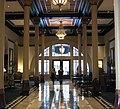
The Mayflower Hotel is a historic hotel in downtown Washington, D.C., located on Connecticut Avenue NW. It is two blocks north of Farragut Square. The hotel is managed by the Autograph Collection Hotels division of Marriott International. The Mayflower is the largest luxury hotel in the District of Columbia, the longest continuously operating hotel in the Washington D.C. area, and a rival of the nearby Willard InterContinental and Hay-Adams Hotels. The Mayflower is known as the "Grande Dame of Washington", the "Hotel of Presidents", and as the city's "Second Best Address" —the latter sobriquet attributed to President Harry S. Truman. It was also a charter member of Historic Hotels of America, the official program of the National Trust for Historic Preservation. Today it is a four-star hotel.
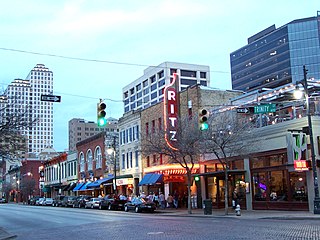
Sixth Street is a historic street and entertainment district in Austin, Texas, located within the city's urban core in downtown Austin. Sixth Street was formerly named Pecan Street under Austin's older naming convention, which had east–west streets named after trees and north–south streets named after Texas rivers.

The Arcade in downtown Cleveland, Ohio, is a Victorian-era structure of two nine-story buildings, joined by a five-story arcade with a glass skylight spanning over 300 feet, along the four balconies. Erected in 1890, at a cost of $867,000, the Arcade opened on Memorial Day, and is identified as one of the earliest indoor shopping arcades in the United States. The Arcade was modified in 1939, remodeling the Euclid Avenue entrance and adding some structural support. It was designated a National Historic Landmark in 1975.

The Bellevue-Stratford Hotel is a landmark building at 200 S. Broad Street at the corner of Walnut Street in Center City Philadelphia, Pennsylvania. Constructed in 1904 and expanded to its present size in 1912, it has continued as a well-known institution for more than a century and is still widely known by that original, historic name. In 1988, the building was converted to a mixed-use development. It has been known since then as The Bellevue. The hotel portion is currently managed by Hyatt as The Bellevue Hotel.

The Henry B. González Convention Center is the City of San Antonio's convention center located in Downtown San Antonio, Texas, along the banks of the River Walk.

The Davenport Hotel is a hotel located in Spokane, Washington. Originally a successful high-end restaurant, it is one of the possible places where the first Crab Louis was created and served. The hotel was designed by architect Kirtland Cutter and built in 1914 for $2 million with an opulent lobby and new amenities for the time such as air conditioning, a central vacuum system, pipe organ, and dividing doors in the ballrooms. Commissioned by a group of Spokane businessmen to have a place to host and entertain their guests, the hotel is named after Louis Davenport, an influential businessman and the first proprietor and overseer of the project.

The Peabody Memphis is a historic luxury hotel in Downtown Memphis, Tennessee, opened in 1925. The hotel is known for the "Peabody Ducks" that live on the hotel rooftop and make daily treks to the lobby. The Peabody is a member of Historic Hotels of America, a program of the National Trust for Historic Preservation.
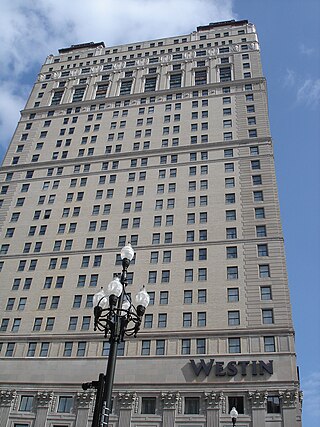
The Westin Book Cadillac Detroit is a historic skyscraper hotel in downtown Detroit, Michigan, within the Washington Boulevard Historic District. Designed in the Neo-Renaissance style, and opened as the Book-Cadillac Hotel in 1924, the 349 ft (106 m), 31-story, 453-room hotel includes 65 exclusive luxury condominiums and penthouses on the top eight floors. It reopened in October 2008, managed by Westin Hotels, after a $200-million restoration.

The Roosevelt New Orleans in New Orleans, Louisiana, is a 504-room hotel owned by AVR Realty Company and Dimension Development and managed by Waldorf Astoria Hotels & Resorts. The hotel was originally built by Louis Grunewald, a German immigrant, and opened in 1893 as "The Hotel Grunewald."

The Rice, formerly the Rice Hotel, is an historic building at 909 Texas Avenue in Downtown Houston, Texas, United States. The current building is the third to occupy the site. It was completed in 1913 on the site of the former Capitol building of the Republic of Texas, and is listed on the National Register of Historic Places. The old Capitol building was operated as a hotel until it was torn down and replaced by a new hotel around 1881. Jesse H. Jones built a new seventeen-story, double-winged hotel in 1913, also called "The Rice Hotel." This building underwent major expansions: adding a third wing in 1925, adding an eighteenth floor in 1951, and adding a five-story "motor lobby" in 1958. In addition, there were several renovations during its life as a hotel. It continued to operate as a hotel before finally shutting down in 1977. After standing vacant for twenty-one years, The Rice was renovated as apartments and reopened in 1998 as the Post Rice Lofts. It was sold in 2014 and renamed simply The Rice.

Bathhouse Row is a collection of bathhouses, associated buildings, and gardens located at Hot Springs National Park in the city of Hot Springs, Arkansas. The bathhouses were included in 1832 when the Federal Government took over four parcels of land to preserve 47 natural hot springs, their mineral waters which lack the sulphur odor of most hot springs, and their area of origin on the lower slopes of Hot Springs Mountain.

The Rainey Street Historic District is a street of historic homes, many of the bungalow style, in downtown Austin, Texas.

The Battle House Renaissance Mobile Hotel & Spa, is a historic hotel in Mobile, Alabama. The current structure was built in 1908 as the Battle House Hotel. It is the second hotel by that name to stand in this location, replacing an earlier Battle House built in 1852, which burned down in 1905. It is one of the earliest steel frame structures in Alabama.
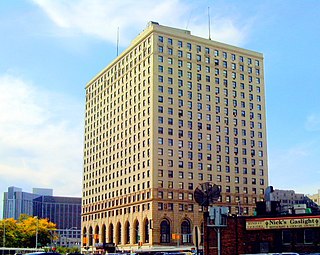
The Detroit-Leland Hotel is a historic hotel located at 400 Bagley Street in Downtown Detroit, Michigan. It is the oldest continuously operating hotel in downtown Detroit, and was listed on the National Register of Historic Places in 2005. The ballroom of the Detroit-Leland has hosted a nightclub, the City Club, since 1983. The hotel is now named The Leland and no longer rents to overnight guests.

The Blackstone Hotel is the tallest hotel in downtown Fort Worth, Texas, at 268 ft (82 m) tall. Located on the corner of Fifth and Main Streets, it is noted for its Art Deco design with terracotta ornamentation and setbacks on the top floors. The hotel was constructed in 1929 and operated for over 50 years before it sat vacant for nearly 20 years. The Blackstone Hotel guest list is full of notable people including Presidents of the United States: Harry S. Truman, Dwight D. Eisenhower, John F. Kennedy, Lyndon B. Johnson, and Richard M. Nixon. The hotel was also host for a few movie stars such as Bob Hope, Clark Gable, and Elvis Presley. It was added to the National Register of Historic Places on February 2, 1984. The building was restored in the late 1990s and is still in use today as the Courtyard Fort Worth Downtown/Blackstone, although it is still known as the "Blackstone Hotel" to those who live in or have ties to Fort Worth.
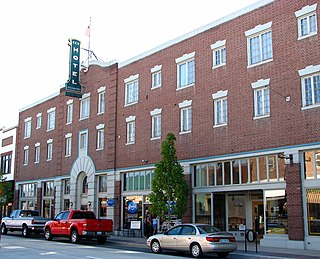
The New Redmond Hotel is a historic commercial hotel in Redmond, Oregon, United States. The hotel was built in 1928 after the original Redmond Hotel, was destroyed in a fire. It is a three-story Georgian-style brick masonry building located on 6th Street in downtown Redmond. It has been in continuous use as a commercial hotel since it first opened. Today, the New Redmond Hotel is a major landmark in downtown Redmond. Because of its importance to the history of Redmond, the New Redmond Hotel is listed on the National Register of Historic Places. On August 1, 2019, Soul Community Planet announced that after a two-year, $7 million renovation, The New Hotel Redmond by SCP opened in the Fall of 2019. The 41,000 square-foot, 49-room hotel, was redeveloped in partnership with the city of Redmond. The Rooftop, a 1,500 square-foot rooftop social garden, was added, opened in August. The redevelopment was made possible through a public-private partnership between the city of Redmond and the developer – a partnership managed by Alpha Wave Investors and RevOZ Capital. The city of Redmond, through its Redmond Urban Renewal Agency, provided a $3.53 million investment in the project.
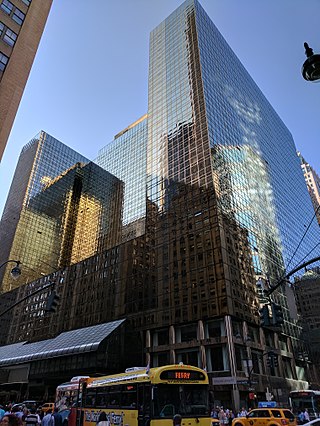
The Hyatt Grand Central New York is a hotel located at 109 East 42nd Street, adjoining Grand Central Terminal, in the Midtown Manhattan neighborhood of New York City. It operated as the 2,000-room Commodore Hotel between 1919 and 1976, before hotel chain Hyatt and real estate developer Donald Trump converted the hotel to the 1,400-room Grand Hyatt New York between 1978 and 1980. As of 2019, the hotel is planned to be replaced with a skyscraper named Project Commodore after 2023.

Grand Hyatt Washington is a hotel in Washington, D.C., in the United States. The 897-room hotel, located at 1000 H Street NW, serves both tourist and business travel. From the time the hotel opened until 2003, it was directly across from the Washington Convention Center and served as a "convention headquarters" hotel for many conventions. The convention center closed and was demolished in 2004. CityCenterDC, a major office, residential, and retail complex, now occupies the site.
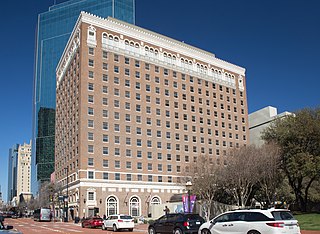
The Hilton Fort Worth is a historic hotel in downtown Fort Worth, Texas.

The Renaissance Cleveland Hotel is a historic hotel on Public Square in Cleveland, Ohio, opened in 1918 as the Hotel Cleveland. It is today part of the Tower City Center mixed-use complex.






